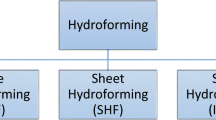Abstract
Spinning processes are typically performed on multi-station mandrels whose operation costs time and effort. In the present work, a novel compound tool was developed with multi-stage single-station approach. The compound tool consists of a number of successive movable interfered mandrels (SMIM) that suit the needed number of stages of the spun part. These mandrels are assembled together with stoppers and special springs that serve as ejectors. During operation, the movable interfered mandrels are released successively in a telescopic fashion from the outermost to the innermost to produce the spun part. A rigorous analysis for all the technical aspects of spun part and tool design is presented. The process design parameters of the spinning process were calculated. Experimental work was conducted and verified the success of the developed tool.
Similar content being viewed by others
References
Li Y, Wang J, Lu G-d, Pan G-j (2014) A numerical study of the effects of roller paths on dimensional, precision in die-less spinning of sheet metal. J Zhejiang Univ Sci A (Appl Phys Eng) 15(6):432–446
López de Lacalle LN, Lamikiz A, Sánchez JA, Arana JL (2007) The effect of ball burnishing on heat-treated steel and Inconel 718 milled surfaces. Int J Adv Manuf Technol 32:958–968
LópezdeLacalle LN, Rodrيguez A, Lamikiz A, Celaya A, Alberdi R (2011) Five-axis machining and burnishing of complex parts for the improvement of surface roughness. Mater Manuf Process 26:997–1003
Rodríguez A, LópezdeLacalle LN, Celaya A, Lamikiz A, Albizuri J (2012) Surface improvement of shafts by the deep ball-burnishing technique. Surf Coat Technol 206:2817–2824
Ragab MS, Orban HZ (2000) Effect of ironing on the residual stresses in deep drawn cups. J Mater Process Technol 99:54–61
Musica O, Allwooda JM, Kawaib K (2010) A review of the mechanics of metal spinning. J Mater Process Technol 210:3–23
Quigleya E, Monaghan J (2000) Metal forming: an analysis of spinning processes. J Mater Process Technol 103:114–119
Sekiguchia A, Araib H (2012) Control of wall thickness distribution by oblique shear spinning methods. J Mater Process Technol 212:786–793
Sekiguchi A, Arai H (2012) Control of wall thickness distribution by oblique shear spinning methods. J Mater Process Technol 212:786–793
Kwiatkowski L, Tekkaya AE, Kleiner M (2013) Fundamentals for controlling thickness and surface quality during dieless necking-in of tubes by spinning. CIRP Ann Manuf Technol 62:299–302
Özer A, Sekiguchi A, Arai H (2012) Experimental implementation and analysis of robotic metal spinning with enhanced trajectory tracking algorithms. Robot Comput Integr Manuf 28:539–550
Wang L, Long H (2011) A study of effects of roller path profiles on tool forces and part wall thickness variation in conventional metal spinning. J Mater Process Technol 211:2140–2151
Kang D, Gao X, Meng X, Wang Z (1999) Study on the deformation mode of conventional spinning of plates. J Mater Process Technol 91:226–230
Wang L, Long H (2013) Roller path design by tool compensation in multi-pass conventional spinning. Mater Des 46:645–653
Wong CC, Dean TA, Lin J (2003) A review of spinning, shear forming and flow forming processes. Int J Mach Tools Manuf 43:1419–1435
Sivanandini M, Dhami SS, Pabla BS (2012) Flow forming of tubes—a review. Int J Sci Eng Res 3(Issue 5):1–11
Silva MB, Skjoedt M, Atkins AG, Bay N, Martins PAF (2008) Single-point incremental forming and formability–failure diagrams. J Strain Anal 43:15–35
Kim TJ, Yang DY (2000) Improvement of formability for the incremental sheet metal forming process. Int J Mech Sci 42:1271–1286
Xia QX, Xie SW, Huo YL, Ruan F (2008) Numerical simulation and experimental research on the multi-pass neck-spinning of non-axisymmetric offset tube. J Mater Process Technol 206:500–508
Liu C (2007) The simulation of the multi-pass and die-less spinning process. J Mater Process Technol 192–193:518–524
Quigleya E, Monaghan J (2002) Enhanced finite element models of metal spinning. J Mater Process Technol 121:43–49
Wang L, Long H (2011) Investigation of material deformation in multi-pass conventional metal spinning. Mater Des 32:2891–2899
Sebastiani G, Brosius A, Ewers R, Kleiner M, Klimmekb C (2006) Numerical investigation on dynamic effects during sheet metal spinning by explicit finite-element-analysis. J Mater Process Technol 177:401–403
Marghmaleki IS, Beni YT, Noghrehabadi AR, Kazemic AS, Abadyan M (2011) Finite element simulation of thermo mechanical spinning process. Procedia Eng 10:3769–3774
Zoghi H, Arezoodar AF, Sayeaftabi M (2013) Enhanced finite element analysis of material deformation and strain distribution in spinning of 42CrMo steel tubes at elevated temperature. Mater Des 47:234–242
Akkusa N, Kawahara M (2006) An experimental and analytical study on dome forming of seamless Al tube by spinning process. J Mater Process Technol 173:145–150
Ma F, Yang H, Zhan M (2010) Plastic deformation behaviors and their application in power spinning process of conical parts with transverse inner rib. J Mater Process Technol 210:180–189
Zhang J, Zhan M, Yang H, Jiang Z, Han D (2012) 3D-FE modeling for power spinning of large ellipsoidal heads with variable thicknesses. Comput Mater Sci 53:303–313
Kawai K, Yang LN, Koudo H (2001) A fixable shear spinning of truncated conical shells with general propose mandrel. J Mater Process Technol 113:28–33
Kawai K, Yang LN, Koudo H (2001) A fixable shear spinning of axi-symmetrical shells with general propose mandrel. J Mater Process Technol 113:13–17
SMI (2002) Handbook of spring design. Edition 2002, Publications of Spring Manufacturer Institute (SMI), Oak Brook, Illinois 60523-1335 USA
Fletter PR. Metal Spinning. V1.0, http://www.fdp.nu/mikelldevice/spinning.pdf, •perf• 11.10.95
Abdel-Magied RK, Wifi AS, Gomaa AH (2003) A rule-based process planning system for axi-symmetrical deep drawing process. Proceedings of AMPT2003, 8-11 July, Dublin, Ireland, pp 462-465.
Author information
Authors and Affiliations
Corresponding author
Rights and permissions
About this article
Cite this article
Abdel-Magied, R.K. A novel technique with compound tool for multi-stage metal spinning. Int J Adv Manuf Technol 79, 57–63 (2015). https://doi.org/10.1007/s00170-015-6805-z
Received:
Accepted:
Published:
Issue Date:
DOI: https://doi.org/10.1007/s00170-015-6805-z




